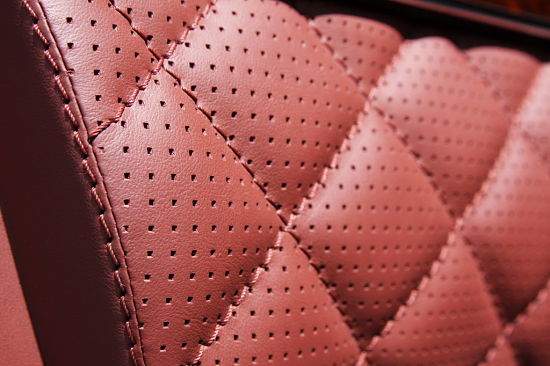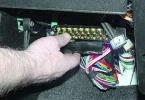The car provides comfortable and fast movement of a person. At the same time, a significant part of ensuring the comfort of each car falls on its interior.
During vehicle operation, the interior trim is exposed not only to high and low temperatures in different seasons, but also to sunlight, which leads to fading of the color of the interior elements. To a large extent, the person himself influences the salon. Over time, the seat upholstery can fray or tear, it can become heavily soiled, or it can be burned out by a cigarette. On the plastic elements of the interior - the front panel and door cards, scratches can form, not only spoiling the appearance of the trim element, but also quickly becoming clogged with dirt and dust. Inaccurate loading, especially in hatchbacks, crossovers and station wagons, can damage the headliner.
Padding the car interior, for example, with leather, can change and decorate its appearance
As a result, the salon loses its appearance and no longer pleases the eyes of the car owner. To correct the current situation with an unpresentable look, the car's interior can be upholstered. In addition, many car owners are trying to give their car a certain personality, including in the cabin. In this case, the same constriction of the car interior plays an important role.
The upholstery of the car interior allows you to restore the appearance of almost any element of the passenger compartment, be it the seats, the dashboard or the ceiling. Nowadays, many tuning studios make it possible to both restore the interior externally and give it individuality. They do such an operation with high quality, but such ateliers have a drawback - this is the cost of such a service. Many car owners decide to do the hauling of the cabin with their own hands, although it is not easy to do this, as it might initially seem.
Video: Padding the car interior
Do-it-yourself upholstery of the salon is done sequentially in several stages. The first thing to do is to decide whether the hauling will be completed completely or only some elements.
For example, if the car owner has damaged only the upholstery of the seats, then he does not need to redo the entire interior, it is enough to replace the upholstery or just buy new covers. Although if it is decided to change the style of the cabin and make it individual, it will require a hauling of all elements of the car's interior.
Selection of material and tools. Preparatory work
Initially, you need to decide on the material that will be used to stretch the interior. This is already a matter of taste. Alcantara is a popular material nowadays. You can use leather or leatherette, and there are plenty of other options. At the same time, the selection of material is a serious matter. Low-quality material will not last long and all costs will be in vain.
![]()
There is a large selection of leather or suede material on the market for upholstering the car interior
In addition to the material, you will also need the presence of threads for sewing individual pieces of material into one whole. Regular threads will not work; this will require special threads. These threads are often sold where the material is.
Even at the stage of material selection, you should decide on the future interior colors. It is not necessary to make the salon in one color, you can use materials of different colors, but it is important to take into account that the finishing material with different colors should be in good harmony with each other. In order for the color solutions of the interior trim to combine well with each other, as well as with the color of the car, you can use the special tables available on the Internet or consult a tuning studio, although such consultation may be paid.
The same situation with color matching and sewing threads. Without sufficient experience with a sewing machine, it will be difficult to make a straight stitch when sewing. As a result, if threads were used that strongly contrast with the material, all the irregularities of the seams will be strongly manifested, so it is better to purchase threads to match the material, well, or not very much in color.

Smooth stitching with threads when tightening the cabin is a rather laborious process and requires skills
We figured out the material for the waist of the car interior, then you can proceed to the preparatory work. Preparatory work is reduced to dismantling all elements of the cabin, which will be covered with new material. In general, to complete all the work you will need:
- Material (alcantara, leatherette, leather);
- Sewing threads;
- Foam rubber (fabric-based);
- Sewing machine;
- A set of keys and tools (for dismantling elements);
- Construction knife;
- Tailors scissors;
- Glue;
- Spray glue;
- Degreaser;
- Sandpaper (fine-grained);
- Foam roller;
- Brushes and spatulas;
The first step is to remove all interior elements from the car, which will be fitted. This will require a standard set of keys and use them carefully to remove the elements. First you need to dismantle the seats, then the door cards. When removing the dashboard, it is better to carefully study the attachment points, since a significant amount of on-board wiring is suitable for it. It is necessary to carefully dismantle the dashboard from the car, it is better to mark some elements of the wiring, so as not to get confused in the future.
Then you can already remove the door cards from the interior and dismantle the ceiling.
Do-it-yourself car upholstery
Some say that do-it-yourself car styling should be done from more complex elements to simple ones. But if the hand-made hauling of the cabin is done for the first time, then on the contrary, it is better to start from simple elements. This will provide the first skills for implementation, during the work it will show which features need to be taken into account and which tools are best to use.
Video: Padding the cabin with Alcantara
As already mentioned, it is better to start the hauling of the car interior with simple elements, i.e. from door cards. They are wrapped in several stages.
- The dismantled door cards must be prepared before wrapping. To do this, wash them thoroughly, removing dirt and dust, and then dry them.
- Fine-grained emery paper must be carefully cleaned the surface. The dust formed as a result of stripping must be removed from the surface with a rag.
- The prepared surface must be treated with a degreaser. It is better to use special degreasers, but you can also use gasoline. It is not advisable to use "Solvent" and White Spirit.
- Attach material to the prepared map and make a cut, ensuring good margins along the edges. Subsequently, the excess will be cut off.
- Apply a layer of glue to the card surface. On flat areas, you can use a spatula for this, if there are complex bends on the surface, then it is better to use a brush for application there. A layer of glue must also be applied to the prepared piece of material. After application, the glue should dry out a little.
- The adhesive is applied to one side of the card and flattens well. Then the material is sequentially applied to the entire surface, while carefully leveled. You can use a roller for this. It will ensure proper adhesion of the material and smooth the surface well.
- Having laid the material over the entire area of the card, you can proceed to the bends. To do this, cut off the excess material, leaving about 2 cm required for the fold. The surface of the material and the card on the fold should also be carefully coated with glue. In order not to form folds at the corners, the material in those places must be carefully cut. After applying the material on the fold, it also needs to be smoothed well. For a better glue setting, you can use a hair dryer, but it is important not to overheat the material.
- As with the bends, you need to do with the twisting of the material in the technological holes (holes for handles, power windows);
- After gluing the wrapped card, it takes time for the glue to set well and dry - about a day.
Padding of the front panel is carried out according to the principle of working with wrapping door cards. But the panel has a lot of complex bends, so when working with the panel, most of the time will need to be devoted to fitting it in difficult places. Yes, and folds cannot be avoided, but you can try to bring them out to places where they will not be noticeable.
Video: Leather steering wheel cover
Do-it-yourself hauling of the ceiling of the car interior is performed in the same way. But the ceiling has a significant area, so it is better to glue the surface of the ceiling and the material as the material is glued.
Padding of car seats
Seat upholstering is a simple operation. To do this, you need to remove the old covers from the seats, carefully rip them apart at the seams. These pieces of old covers will serve as templates for cutting out new pieces and prepared material. Then the pieces are sewn together, the resulting new cover is put on the seat and fixed on it.
This describes the technology of covering the interior without the use of stitching material, not counting the seats. It is more difficult to perform a close-fitting if several types of material, sewn together, will be applied to the surface.



